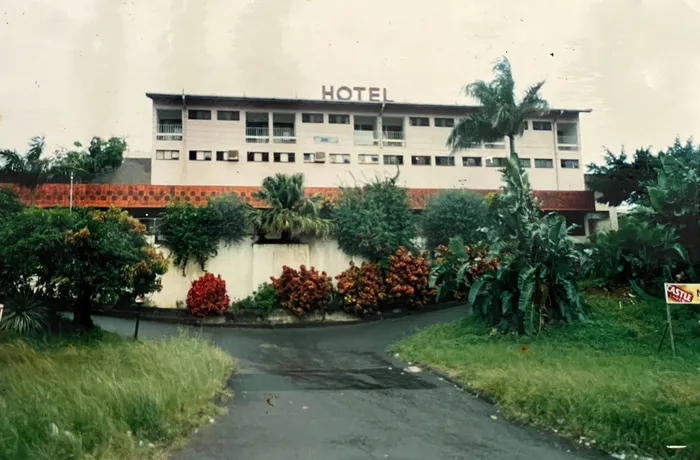Savera’s sailing indenture history

The Hotel Savera at 17 Oak Ave, Kharwastan, Durban, as it stood in 1988. | Shelley Kjonstad Independent Newspapers
Durban — This is no ordinary watering hole. While locals and some influential people wine, dine and indulge in the comforts of Hotel Savera in Chatsworth, this establishment is also steeped in history.
It is a wellspring of knowledge on indentured labourers who were enticed to travel from India to South Africa and their lot thereafter.
Hotel Savera celebrates its 50th anniversary this year and is this week’s Then and Now focus.
Set up on a hill in the quiet neighbourhood of Kharwastan, this “grand old lady” remains the only fully functioning hotel in Chatsworth.
Its 3-star offerings include 20 bedrooms, dining rooms, lounges, authentic cuisine, bar and betting facilities.
The on-site museum is made up of exhibits in three function rooms and a conference hall, providing insight into the voyages of the indentured workers to South Africa, their toil, troubles and, for some, their rise to the top.

Hotel owner Dhilosen Pillay said a production crew from the BBC filmed there for a documentary on Indian indenture, and it has also attracted attention from French and German TV channels.
Pillay said the museum culminates in the India Room conference hall.
“We were able to show what India was like, the ships that brought our forefathers here, the difficulties they had in their designated residential places like ‘Magazine Barracks’.
“The India Room also tells a story of people who have come a long way from their homeland and what their descendants were able to achieve,” said Pillay. Some of the labourers’ progeny who excelled in various fields like the arts, politics, business, and sport are recognised.
They include Billy Nair, a former uMkhonto we Sizwe (military wing of the ANC) commander; Sam Ramsamy, former executive member of the International Olympic Committee, and human rights activist and former Greenpeace executive director Kumi Naidoo.
Singing sensation Shunna (Sonny) Pillay, an internationally recognised jazz singer who worked with the likes of Hugh Masekela and Miriam Makeba, who he was once married to, is also featured.

Sonny Pillay previously had a multimillion-dollar contract with the Music Corporation of America, which literally owned the entertainment industry in the US previously, and it included TV and movie appearances for him.
About the ships that brought workers to South Africa, Dhilosen Pillay said many people only recognised the SS Truro and the SS Belvedere.
“Between 1860 and 1911, a total of 71 ships were used. A ship like the SS Umzinto made 53 trips from 1892 to 1911.”
This history is captured in the Truro Room, which also has a complete log of the trips the 71 ships made.
Pillay said the Truro Room was the first segment of his history project, which came to life in 2009, but his desire to search for his genealogy had begun in the 1990s.
“I was always interested in my roots, who I am and why I’m here.”

It didn’t add up for him that the labourers were ferried to South Africa on only a few boats.
“Through my searching, I learnt that there was information available. It took me to a professor in Pretoria. He had the entire ship listing.”
Pillay explained the professor had to travel to three ports in India as part of his research for a thesis he had worked on.
In days before the internet, Pillay paid for the information the professor had stored on a disc.
More of the indenture-related history is exhibited in the Lotus Room and the Indus Lounge.
Through his research, Pillay found that many labourers of south Indian descent hailed from the Madras Presidency and those from the north had come from Bihar and West Bengal states, contrary to some beliefs.
He said clearing up misconceptions and educating the youth motivated him to create the museum.
“Many of our youth have lost touch with who they are and where they come from.”
Parents usually take their children to the museum when working on projects, but Pillay believes schools have not grabbed the opportunity to bring pupils, especially those in their formative years, to the venue for a better understanding of their heritage.

A strip of land where the hotel stood, which was once a part of the old Kharwa Farm, was sold to the Baker family by a Mr Sewnarain.
The Bakers’ built the hotel around the 1960s for Mr OR Singh and registered it as a company in 1974, but he died before the building was completed.
A member of the Baker family had visited India and stayed at the Savera Hotel in Chennai, which was owned by three Reddy brothers. The hotel’s name was a combination of the brothers’ names.
Pillay’s father Manickum was the major shareholder in the consortium that bought the hotel from the Bakers in 1981.
The consortium had financial difficulties and Manickum bought them out in 1983.
Manickum’s wife Maragathum managed the hotel because he had other business interests.
“Dressed traditionally in her sari, my mother, who was a powerhouse of a woman, became the backbone of the hotel.
“She took on the challenge of working with male clientele in a male-dominated industry,” said Pillay.

As time passed, the hotel business became less lucrative and when he took over in 2004, the building was dilapidated.
“I had a vision of how I wanted to turn it around and achieve three-star status and we started working on it from 2008. Presently, it’s in a modernised state with a family vibe.”
He called on the government to give more recognition to the contributions made by the Indian diaspora, especially in KwaZulu-Natal. Pillay said the colonisers should play a pivotal role in fostering better Indo-African relations.
“When we were brought here we were never given the opportunity to co-exist with our African brothers.”
Independent on Saturday
Related Topics: